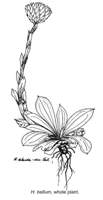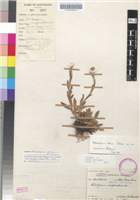Origin of name:
bellus / -a/ -um = pretty
Diagnostic characters:
Large solitary heads
White bracts
Description:
Perennial herb with 1 or a few leaf rosettes crowning a woody rhizome, flowering stems terminal, but lateral to the new rosettes, 1 or 2 from a rosette, decumbent then erect to c. 150 (�300) mm, loosely greyish-white woolly, closely leafy. Radical leaves up to 150 x 20 mm, but commonly not more than 50 x 15 mm, lanceolate-spathulate or lanceolate-elliptic, membranous, glandular-pilose, margins white-woolly particularly when young; cauline leaves similar but smaller and diminishing in size upwards. Heads heterogamous, campanulate, c. 15 mm long, double that across the radiating bracts, solitary, very rarely paired. Involucral bracts in c. 10 series, graded loosely imbricate, much exceeding the flowers, acute, snow-white. Receptacle nearly smooth. Flowers 287�544, 31�67 female, 256�478 homogamous. Achenes 1.5 mm, ellipsoid, strongly 5-ribbed, glabrous. Pappus bristles many, about equaling corolla, scabridulous, bases sometimes lightly cohering by patent cilia.
Flowering between January and March
Distribution:
Grows scattered in stony turf on steep slopes and on the summit plateau. On the high Lesotho mountains and the high Drakensberg from Mont aux Sources south to Barkly Pass in the Cape Drakensberg and the nearby Witteberg, between 2 400 and 3 300 m.
Grassland Biome.
Notes:
See H. marginatum and H. palustre.
Taxonomy:
Literature:
Helichrysum bellum Hilliard in Notes R. bot. Gdn Edinb. 31: 15 (1971), Compositae in Natal 233 (1977).
Type:
KwaZulu-Natal-Lesotho border, top of Bushman's River Pass, c. 3 050 m, Wright 436 (NU, holo.; E; K; NH; PRE; S, iso.).
Synonym(s):
Vouchers:
Hilliard 5291 (E; K; NU; S); Nordenstam 2020 (LD; NU); Wright 1107 (E; K; NU).


